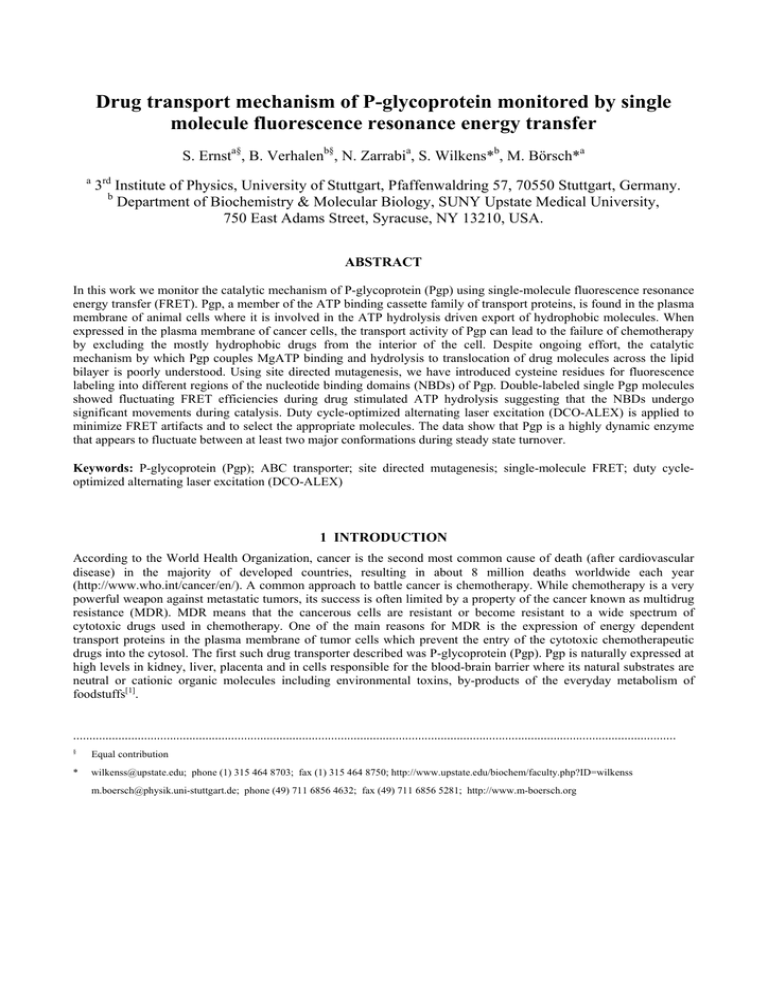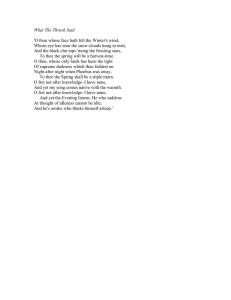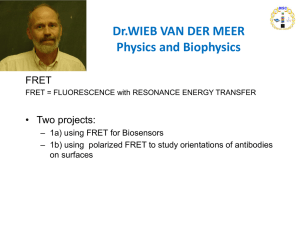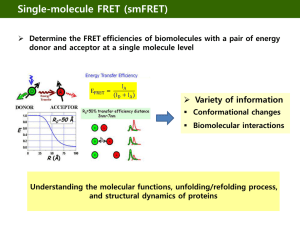Experimental procedures
advertisement

Drug transport mechanism of P-glycoprotein monitored by single
molecule fluorescence resonance energy transfer
S. Ernsta§, B. Verhalenb§, N. Zarrabia, S. Wilkens*b, M. Börsch*a
a
3rd Institute of Physics, University of Stuttgart, Pfaffenwaldring 57, 70550 Stuttgart, Germany.
b
Department of Biochemistry & Molecular Biology, SUNY Upstate Medical University,
750 East Adams Street, Syracuse, NY 13210, USA.
ABSTRACT
In this work we monitor the catalytic mechanism of P-glycoprotein (Pgp) using single-molecule fluorescence resonance
energy transfer (FRET). Pgp, a member of the ATP binding cassette family of transport proteins, is found in the plasma
membrane of animal cells where it is involved in the ATP hydrolysis driven export of hydrophobic molecules. When
expressed in the plasma membrane of cancer cells, the transport activity of Pgp can lead to the failure of chemotherapy
by excluding the mostly hydrophobic drugs from the interior of the cell. Despite ongoing effort, the catalytic
mechanism by which Pgp couples MgATP binding and hydrolysis to translocation of drug molecules across the lipid
bilayer is poorly understood. Using site directed mutagenesis, we have introduced cysteine residues for fluorescence
labeling into different regions of the nucleotide binding domains (NBDs) of Pgp. Double-labeled single Pgp molecules
showed fluctuating FRET efficiencies during drug stimulated ATP hydrolysis suggesting that the NBDs undergo
significant movements during catalysis. Duty cycle-optimized alternating laser excitation (DCO-ALEX) is applied to
minimize FRET artifacts and to select the appropriate molecules. The data show that Pgp is a highly dynamic enzyme
that appears to fluctuate between at least two major conformations during steady state turnover.
Keywords: P-glycoprotein (Pgp); ABC transporter; site directed mutagenesis; single-molecule FRET; duty cycleoptimized alternating laser excitation (DCO-ALEX)
1 INTRODUCTION
According to the World Health Organization, cancer is the second most common cause of death (after cardiovascular
disease) in the majority of developed countries, resulting in about 8 million deaths worldwide each year
(http://www.who.int/cancer/en/). A common approach to battle cancer is chemotherapy. While chemotherapy is a very
powerful weapon against metastatic tumors, its success is often limited by a property of the cancer known as multidrug
resistance (MDR). MDR means that the cancerous cells are resistant or become resistant to a wide spectrum of
cytotoxic drugs used in chemotherapy. One of the main reasons for MDR is the expression of energy dependent
transport proteins in the plasma membrane of tumor cells which prevent the entry of the cytotoxic chemotherapeutic
drugs into the cytosol. The first such drug transporter described was P-glycoprotein (Pgp). Pgp is naturally expressed at
high levels in kidney, liver, placenta and in cells responsible for the blood-brain barrier where its natural substrates are
neutral or cationic organic molecules including environmental toxins, by-products of the everyday metabolism of
foodstuffs[1].
...........................................................................................................................................................................................
§
Equal contribution
*
wilkenss@upstate.edu; phone (1) 315 464 8703; fax (1) 315 464 8750; http://www.upstate.edu/biochem/faculty.php?ID=wilkenss
m.boersch@physik.uni-stuttgart.de; phone (49) 711 6856 4632; fax (49) 711 6856 5281; http://www.m-boersch.org
Pgp belongs to the superfamily of the adenosine triphosphate (ATP) binding cassette (ABC) transporters. This class of
transporters mediate active translocation across the cell membrane and can be found in all prokaryotic and eukaryotic
cells. The transporters couple the hydrolysis of ATP to translocation of a broad range of substrates across the
membrane[2]. ABC transporters are characteristically composed of two transmembrane domains (TMDs) and two
nucleotide binding domains (NBDs). In Pgp, the domain organization given by the primary sequence is N-TMD1NBD1-TMD2-NBD2-C. The TMDs of Pgp are each composed of six transmembrane α helices. ATP hydrolysis takes
place at the interface of the two NBDs while the transport channel in which the substrate crosses the lipid bilayer is
formed by the two TMDs. Together, the four domains form a transporter with pseudo two-fold symmetry that extends
136 Å perpendicular and 70 Å parallel to the plane of the membrane[3] (Fig. 1).
Due to the important role of Pgp in cancer research, Pgp is one of the best characterized ABC transporters. Based on a
wealth of structural data from electron microscopy[4, 5] and X-ray crystallography[6], together with results from
biochemical and biophysical experiments including chemical cross-linking, fluorescence and EPR spectroscopy as well
as nucleotide, drug and inhibitor binding studies, a picture of the catalytic mechanism of Pgp is emerging in which
binding and hydrolysis of MgATP in alternating catalytic sites on the NBDs is coupled to drug binding and transport
via out- and inward facing conformations of the two transmembrane domains[7-12]. A schematic of the in- and outward
facing conformations is shown in Figure 1A.
Figure 1: Basic mechanism of P-glycoprotein (Pgp) and experimental design of single-molecule fluorescence
resonance energy transfer (FRET) to monitor conformational changes in solution. (A) Information gained
from structural studies show two main catalytic states of ABC transporters, the outward and inward facing
conformation. The inward conformation is where the TMDs are open towards the cytosol. For exporters such as
Pgp, this is thought to allow the transporter to acquire substrate (drug) from the inner leaflet of the bilayer and then
move the substrate towards the outside of the cell, depicted by the outward facing conformation. (B) The Pgp
structure[3] (Aller, 2009, PDB ID 3g5u) is displayed with the Walker A motif and Signature Sequence in space fill
(notated in the top view of Pgp, bottom panel). Also in space fill are the two residues genetically modified to
cysteines for fluorophore labeling (Thr 492 and Ser 1137). (C) A proteoliposome containig a single Pgp is freely
diffusing through the confocal volume of the lasers drawn as gray cone.
Details of this mechanism, such as the order of the various steps and the degree of motion of the NBDs, however, are
still poorly understood. To delineate the conformational changes Pgp is undergoing during the transport cycle, we
developed a single-molecule fluorescence approach (as previously reported to observe the rotary subunit movements in
FoF1-ATP synthase[13-19]) that allows monitoring of NBD dynamics in individual membrane bound transporters. In this
assay, proteoliposomes (with a diameter of 70-150 nm) that contain a single Pgp labeled with donor and acceptor dyes
(Fig. 1B) are allowed to diffuse freely through a confocal volume of focused laser light (Fig. 1C). We apply single-
molecule Förster-type fluoresence resonance energy transfer (FRET) to monitor the distance changes between the two
nucleotide binding domains. The well-known distance dependence of FRET is widely used to map the spacing between
two intramolecular or intermolecular positions in the range between 2 and 8 nm[17, 20-25]. Based on recent X-ray crystal
structures of ABC transporters in general and Pgp in particular, conformational changes during the transport cycle are
predicted to result in a sequence of distance changes between the two NBD bound fluorophores, leading to a step wise
change in FRET efficiency. Real time monitoring of FRET efficiencies with millisecond time resolution and subnanometer precision is a powerful tool for gaining a deeper understanding of the structural changes that couple binding
and hydrolysis of MgATP to binding and translocation of drug molecules. In this work, we conducted single-molecule
FRET experiments using Pgp double mutant TS, in which Thr 492 in NBD1 and Ser 1137 in NBD2 were replaced by
cysteine residues for labeling with maleimide linked fluorescent dyes (Figure 1B; dark grey). In a series of experiments,
we monitored FRET efficiencies of single Pgp molecules under conditions of 'apo' (no drugs or nucleotides), 'transport'
(MgATP + verapamil), 'vanadate trapped' (MgATP, verapamil + orthovanadate) and modulation by cyclosporin A. The
data show that Pgp fluctuates between two major conformations, one with high and one with lower FRET efficiency
during drug stimulated ATP hydrolysis. Additional states are observed that are less populated, possibly because they are
short lived. The findings are discussed in context of the available structural and biochemical data and a model of the
transport mechanism of Pgp is presented.
2 EXPERIMENTAL PROCEDURES
2.1 Sample preparation
Single-molecule FRET experiments were carried out with P-glycoprotein labeled on NBD1 and NBD2 with donor and
acceptor dyes. Mouse mdr3 (Pgp) was expressed in Pichia pastoris and purified as described by Lerner-Marmarosh et
al.[26], with minor modifications. After anion exchange with DE-52 resin, protein was concentrated and applied to a
Superdex 200 size exclusion chromatography column (10/30; GE Healthcare) in 10 mM Mops, 50 mM NaCl, 10%
glycerol, 0.5 mM EDTA, 0.5% CHAPS, 0.1 mM TCEP, pH 7.0. The protein was mixed with a molar excess of
Alexa488-maleimide and Atto610-maleimide and incubated for one hour at 20 °C. Binding of excess dye was
terminated by addition of 1 mM cysteine for 10 minutes at 20 °C. Labeling efficiency was determined by UV-Vis
absorption spectroscopy. The protein to dye ratio needed for stoichiometric labeling was determined by testing multiple
ratios. The labeled protein was then added to a 19:1 PC:PA lipid mix in the ratio of 1:1739 protein:lipid (w/w). The
protein was reconstituted into proteoliposomes via gel filtration using a Sephadex G50 gravity flow column.
2.2 Single-molecule FRET measurements
For the excitation of the two FRET fluorophores two lasers were used. For the FRET donor excitation a fiber coupled
picosecond laser at 488 nm (PicoTa 490, up to 80 MHz repetition rate, Picoquant) was applied. The second HeNe laser
provided continuous-wave laser light at 594 nm (Coherent, 05-LYR-173). The laser was switched in the nanosecond
range via an acousto-optical modulator (AOM, model 3350-192, Crystal technologies). Both lasers were triggered and
synchronized by an programmable external pulse generator[27]. The intensity for the FRET donor excitation laser at 488
nm was attenuated to 150 µW, and the laser power for the acceptor test at 594 nm was set to 30 µW to avoid
photobleaching of the fluorophores.
In order to obtain an enlarged confocal volume for the solution measurements, the two laser beams were compressed by
a pair of lenses. For the 488 nm laser beam, a set of semi concave lenses with a focus of 250 mm and 40 mm were used.
The 594 nm laser beam was compressed by a factor of 4:1. Both were overlaid manually using a dichroic beam splitter
(DCXR 488, AHF Tübingen). The correct position of the two focal spots was controlled by scanning multicolor
fluorescent beads with a diameter of 1 µm (transfluospheres 488/635, Molecular Probes) with both excitation lasers.
The scanning procedure was accomplished by an x-y piezo scanner plus piezo objective positioner (Physik
Instruments)[28, 29]. The digital controller of the scanner was addressed by a custom made LabView software. The center
of the Gaussian intensity distributions was determined and the distance of the foci was minimized. The automatic
analysis was performed by custom scripts written in MATLAB. The microscope setup is drawn in Fig. 2.
Figure 2: Single-molecule FRET microscopy setup. For the FRET experiments, a pulsed laser at 488 nm (FRET
donor excitation) and an AOM-switched He/Ne laser at 594 nm for the FRET acceptor test was used.
The measurement setup is based on a custom built inverted confocal microscope (Olympus IX71). Laser excitation and
fluorescence detection pathways were modified compared to previously reported detection schemes[30-38]. The laser
beams were redirected by a dichroic filter (488/595, AHF) after entering the epifluorescent port of the microscope and
focused into the solution by a water immersion objective (UPlanSApo 60xW, 1.2 N.A., Olympus). The fluorescent
signal of the sample passed a 150 µm pinhole and was separated into two different spectral ranges with a dichroic beam
splitter (DCXR 575, AHF). The emerging photons of both spectral ranges were recorded simultaneously by two
avalanche photo diodes (AQR-14, Perkin Elmer). The fluorescent signal of Alexa488 was detected between 497 and
567 nm (HQ 532/70, AHF) and the signal of Atto610 from 595 nm (LP595, AHF). Single photons were registered by
two synchronized TCSPC cards (SPC-152, Becker & Hickl) and simultaneously by a multi-channel counter card for
imaging (NI.PCI 6602, National Instruments). With this setup it was possible to use the microtime tag of each photon
registered with picosecond resolution, that is, related to the synchronization pulse of the TCSPC electronics, to obtain
the FRET efficiency[29].
The time trajectories of the fluorescence signals were further analyzed with our custom software "Burst-analyzer"[36].
Single-molecule measurements with solutions of donor and acceptor dye only served for background corrections, and
the fluorescence intensities of both detecting channels were adapted accordingly. Briefly, for FRET donor and acceptor
channels, a background of 11 and 5 counts/ms were subtracted, respectively. Also the detection efficiencies of both
detection channels as well as the quantum yields of the two dyes were taken into account. The correction factor γ of the
single-molecule FRET experiments was determined to be 0.79.
In order to select only single Pgp molecules with the correct combination of FRET fluorophores linked to the nucleotide
binding domains (one donor and one acceptor), duty cycle-optimized alternating laser excitation (DCO-ALEX) was
used[39] (Fig. 3A). With this approach we could eliminate photon bursts originating from incorrectly labeled Pgp
molecules that otherwise could have been misinterpreted as apparent FRET signals, that is, Ppg labeled with donor
only, acceptor only, or doubly labeled with either two donors or two acceptors. By gating the microtime, histograms of
both TCSPC channels were separated (Fig. 3B). The time trajectories for the FRET traces and the acceptor test traces
were reconstructed for each fluorophore based on the laser pulses.
For the correct sorting of photons (i.e. depending on the exciting laser pulse) a fast triggering of the two lasers and the
photon counting electronics in the nanosecond range is required. This was achieved by an arbitrary waveform generator
(AWG2041, Tektronix) with a time resolution of 1 ns. With this device we were able to optimize the duty cycle for
each laser independently and additionally trigger both TCSPC cards.
Figure 3: TTL pulse sequences generated by the arbitrary waveform generator for duty cycle-optimized
alternating pulsed laser excitation. (A) Trigger pulse sequence for the PicoTA 490, the AOM for the HeNe laser,
and the synchronization of the TCSPC cards. (B) Microtime histogram of the photons as detected by the two APDs
in one period of 96 ns. The FRET measurement was completed in the first 64 ns of the 96 ns cycle. In the second
time window (from 64 to 96 ns) a second laser pulse was applied to probe the acceptor dye.
The single-molecule FRET experiment was divided into two time windows. In the first time window, the FRET
measurement was carried out with four consecutive pulses of the exciting laser for the FRET donor. Each laser pulse
was 60 ps long and delayed by 16 ns. In the second time window, one laser pulse with the 594 nm wavelength was used
in order to install a so called "acceptor test" for a duration of 16 ps (Fig. 3). This kind of test allows incorrectly labeled
proteins (singly labeled or doubly labeled with either the donor or acceptor only) to be filtered out. The interval of the
second time window was 32 ns. A 16 ns pulse for the AOM switched the HeNe laser beam on, and the following 16 ns
pause switched it off. With this duty cycle scheme the complete fluorescence decay of both dyes was recorded. The
maximum excitation rate of the FRET donor of 83.3 MHZ dropped down to 51% (i.e. 42.5 MHz) instead of down to
only 26% (21.7 MHz) in a standard alternating laser excitation approach.
3 RESULTS
To monitor the transport cycle of a single Pgp molecule using single-molecule FRET, we attached donor and acceptor
fluorophores to the protein, one to each NBD. For maleimide based labeling, two cysteines were introduced at positions
T492 and S1137 (mutant ‘TS’) by site directed mutagenesis. After the labeling reaction Pgp was reconstituted into
PC:PA (19:1) liposomes with a diameter of 70 to 150 nm. Two alternating lasers at 488 nm and 594 nm were used to
excite the FRET donor and to probe the presence of the FRET acceptor, respectively. The laser pulse sequence was
optimized for a high duty cycle to excite the FRET donor. Briefly, a series of four pulses at 488 nm was followed by
one AOM-switched pulse at 594 nm.
Fig. 4 shows the photon bursts of a single Pgp transporter. In the lower panels, the fluorescence intensity trajectories of
FRET donor Alexa488 and of FRET acceptor Atto610 on both NBDs are shown. The black traces show the donor
intensity, the light gray the FRET signal and the dark gray trace displays the corresponding FRET acceptor intensity
trajectory upon direct excitation, confirming the existence of the Atto610 dye. In the upper panels the distance of both
fluorophores is displayed. FRET distances in each time interval were calculated by the following formula:
where IA and ID are the background-corrected fluorescence intensities in the FRET acceptor and FRET donor channels
and γ the correction factor combining quantum yields of the dyes and the detection efficiencies of both detection
channels. R0 is the Förster distance and RDA the distance between donor and acceptor fluorophores. For the FRET pair
used here (Alexa488 and Atto610), the Förster radius was calculated to R0 = 5.7 nm with a γ factor of 0.79.
For the Pgp in Fig. 4A no nucleotide was added before the measurement ('Apo'). A mean FRET distance of 6.1 nm only
displays minor fluctuations in the absence of substrates while the liposome was in the confocal focus between 50 and 75
ms as shown in the FRET distance trace above. However, in the presence of 200 µM verapamil and 1 mM MgATP
('Transport') the fluorescence intensities and the FRET efficiency changed (Fig. 4B). In the first 21 ms after the
liposome entered the confocal focus the FRET distance was around 5.5 nm. After that the distance of the two NBDs
slightly increased, followed by a sharp increase of FRET efficiency (or decrease in distance) to around 4 nm.
Figure 4: Time trajectories of the FRET efficiency changes of a single Pgp transporter labeled with Alexa488
(donor) and Atto610 (acceptor) reconstituted in a liposome. The intensity traces are background corrected, and the
quantum yields and the detection efficiencies were taken into account. The black traces show the donor intensity, the
light gray the FRET acceptor intensity and the dark gray traces are the acceptor test signal. (A) Measurement without
any nucleotide or drug binding ('Apo' condition). The corresponding FRET distance trace is shown in the upper panel.
The mean FRET distance of about 6.1 nm does not change with the exception of small fluctuations. (B) A photon
burst of Pgp in the presence of 200 µM verapamil and 1mM MgATP ('Transport' condition) displays several distance
changes, including one rapid step from ~6 nm to ~4 nm.
An automatic search algorithm based on intensity thresholds was applied to find the photon bursts. For the recorded
data only those bursts were analyzed that met the following conditions: the length of a photon burst was between 20 and
250 ms; the acceptor test signal had to be stronger than 10 counts/ms; and the donor signal stronger than 20 counts/ms.
With these search criteria we found 145 bursts for the 'Apo' condition, 908 for 'Transport', 774 for the 'vanadate trapped'
and 574 for the 'cyclosporin A' conditions (vanadate trapped and cyclosporin A data not shown).
The so-called proximity factor P (see histograms in Fig. 5) correlates the intensities of the donor and acceptor channel:
Figure 5: Histogram of the proximity factors of Pgp transporters with two different biochemical conditions. (A)
Apo, no nucleotide or drug. (B) Transport with 200 μM verapamil and 1 mM MgATP.
As can be seen in Fig. 5, for both conditions broad distributions of FRET efficiencies were found by comparing the
proximity factor histograms. In the 'Apo' condition, only a few bursts met the threshold requirements. Most of the bursts
showed no or only one change in the distance between the two fluorophores. One possibility is that a larger population
occupied an open conformation with a very low FRET state and was trapped in this state without any substrate binding.
Proximity factors for 'Transport' condition (verapamil and MgATP) were centered around 0.5, but the histogram was
broadened.
Figure 6: Dwell time histograms for 'Apo' (A) and 'Transport' conditions (B). The dwell time for each condition was
determined by mono-exponential fitting (black curve). The dwell time binning of the histograms was 5 ms.
Fig. 6 shows the dwell time histograms of the two conditions 'Apo' and 'Transport'. The dwell time describes the time
interval in which the Pgp transport cycle remains in the same conformation. From these plots, an idea about the rate of
transitions that occur during different substrate conditions can be made; thus, only completely recorded steps were
taken into account. Using mono-exponential decay fitting (black lines in Fig. 6), the dwell time of each condition was
determined.
The 'Apo' condition appears to populate slow and quick transitions indicating a very flexible molecule, but it has to be
taken into consideration that only a small amount of the recorded photon bursts showed more than one step. As
expected, most of the molecules in absence of substrate occupied predominantly one conformation state. In the presence
of verapamil and MgATP, the dwell times were very short indicating rapid transitions, consistent with rapid MgATP
hydrolysis. Both vanadate trapping and cyclosporin slowed the molecule dynamics down, which supports previous
reports of slowed ATPase transitions and limited NBD-NBD interactions, respectively[40].
In the last step of analysis, distributions of the distance changes were considered under the two conditions 'Apo' and
verapamil/MgATP-driven 'Transport' (Fig. 7). The distance of the two nucleotide binding domains before (FRET
distance 1) and after (FRET distance 2) a conformational change were plotted together resulting in one data point for
two distances. In comparing the transition plots, it was observed that there was a broad distribution in the 'Apo'
condition. However, this was based on a few FRET transitions.
In the presence of MgATP/verapamil two main transitions were found: from 5.4 nm to 5.0 nm and the reverse, as well
as from 5.5 nm to 6.0 nm and back. The spots across the diagonal indicated a fluctuation between two states. This
fluctuation was also present in vanadate trapped and cyclosporin conditions; however, there was only one fluctuation in
each condition. The vanadate trapped molecule occupied the transitions at shorter distances whereas the cyclosporin A
trapped Pgp occupied the lower FRET states (data not shown).
Figure 7: FRET transition density plots of single Pgp transporters. (A) in the absence of ATP and (B) during ATP
hydrolysis. At least two distinct FRET levels had to be detected within each photon burst to be added to the
histograms. In the absence of ATP only few fluctuating transporters were observed.
4 DISCUSSION
In order to address the questions surrounding the conformational changes during the catalytic cycle of Pgp, cysteines
were placed in a cysteine-less mouse Pgp for fluorescent labeling to carry out single-molecule FRET spectroscopy.
Here we show that Pgp can be labeled with two different fluorophores, reconstituted into liposomes, and FRET
efficiency differences can be visualized dependent upon substrate condition. In our preliminary analysis of the double
mutant TS, we observe two major conformations of the transporter, a high FRET state and a low FRET state. In
addition, we see quick fluctuations in presence of verapamil and ATP in contrast to the longer dwell times of vanadatetrapped Pgp and cyclosporin activated Pgp. One limitation of the single-molecule approach used is that the observation
time window (20 to 250 ms) is short compared to the average turnover rate of Pgp of ~1/s under these conditions. This
might explain why only few larger distance steps were measured.
To overcome these observation time limitations of the combination of freely diffusing Pgp proteoliposomes and the
relatively slow turnover by Pgp, a trapping technique has to be applied. A promising new approach is the ABELtrap
which uses electrokinetic forces to hold a liposome in solution. The position of a (fluorescently labeled) proteoliposome
is monitored by an EMCCD camera to generate electrical potentials at electrodes in order to compensate the Brownian
motion[41, 42]. Additionally, Hidden Markov Models (HMM) analysis[43] will provide a more objective way of analyzing
the FRET time trajectories of Pgp to link together the transitions of NBDs of Pgp, and will allow for the next steps in
furthering the understanding of the step-by-step mechanism of Pgp.
Acknowledgements
This work was in part supported by NIH grants CA100246 and GM058600 to S.W.
5 REFERENCES
[1]
[2]
[3]
[4]
[5]
[6]
[7]
[8]
[9]
[10]
[11]
[12]
[13]
[14]
[15]
[16]
[17]
[18]
[19]
[20]
[21]
[22]
[23]
[24]
[25]
[26]
[27]
[28]
[29]
[30]
[31]
[32]
[33]
[34]
[35]
[36]
M.M. Gottesman, T. Fojo, S.E. Bates, Nat Rev Cancer 2002, 2, 48.
R.J. Dawson, K. Hollenstein, K.P. Locher, Mol Microbiol 2007, 65, 250.
S.G. Aller, J. Yu, A. Ward, Y. Weng, S. Chittaboina, R. Zhuo, P.M. Harrell, Y.T. Trinh, Q. Zhang, I.L. Urbatsch, G.
Chang, Science 2009, 323, 1718.
J.Y. Lee, I.L. Urbatsch, A.E. Senior, S. Wilkens, J Biol Chem 2002, 277, 40125.
J.Y. Lee, I.L. Urbatsch, A.E. Senior, S. Wilkens, J Biol Chem 2008, 283, 5769.
J. Chen, G. Lu, J. Lin, A.L. Davidson, F.A. Quiocho, Mol Cell 2003, 12, 651.
D.R. Stenham, J.D. Campbell, M.S. Sansom, C.F. Higgins, I.D. Kerr, K.J. Linton, Faseb J 2003, 17, 2287.
C. Horn, S. Jenewein, B. Tschapek, W. Bouschen, S. Metzger, E. Bremer, L. Schmitt, Biochem J 2008, 412, 233.
C.F. Higgins, K.J. Linton, Nat Struct Mol Biol 2004, 11, 918.
A.E. Senior, M.K. al-Shawi, I.L. Urbatsch, FEBS Lett 1995, 377, 285.
G. Tombline, A.E. Senior, J Bioenerg Biomembr 2005, 37, 497.
I.L. Urbatsch, K. Gimi, S. Wilke-Mounts, A.E. Senior, J Biol Chem 2000, 275, 25031.
M. Borsch, M. Diez, B. Zimmermann, R. Reuter, P. Graber, FEBS Lett 2002, 527, 147.
M. Borsch, M. Diez, B. Zimmermann, M. Trost, S. Steigmiller, P. Graber, Proc. SPIE 2003, 4962, 11.
M. Diez, B. Zimmermann, M. Borsch, M. Konig, E. Schweinberger, S. Steigmiller, R. Reuter, S. Felekyan, V.
Kudryavtsev, C.A. Seidel, P. Graber, Nat Struct Mol Biol 2004, 11, 135.
B. Zimmermann, M. Diez, N. Zarrabi, P. Graber, M. Borsch, Embo J 2005, 24, 2053.
B. Zimmermann, M. Diez, M. Borsch, P. Graber, Biochim Biophys Acta 2006, 1757, 311.
M.G. Duser, Y. Bi, N. Zarrabi, S.D. Dunn, M. Borsch, J Biol Chem 2008, 283, 33602.
M.G. Duser, N. Zarrabi, D.J. Cipriano, S. Ernst, G.D. Glick, S.D. Dunn, M. Borsch, Embo J 2009, 28, 2689.
T. Forster, Naturwissenschaften 1946, 33, 166.
S. Steigmiller, B. Zimmermann, M. Diez, M. Borsch, P. Graber, Bioelectrochemistry 2004, 63, 79.
T. Krebstakies, B. Zimmermann, P. Graber, K. Altendorf, M. Borsch, J.C. Greie, J Biol Chem 2005, 280, 33338.
T. Heitkamp, R. Kalinowski, B. Bottcher, M. Borsch, K. Altendorf, J.C. Greie, Biochemistry 2008, 47, 3564.
M. Diez, M. Borsch, B. Zimmermann, P. Turina, S.D. Dunn, P. Graber, Biochemistry 2004, 43, 1054.
M. Borsch, Biological Chemistry 2011, 392, 135.
N. Lerner-Marmarosh, K. Gimi, I.L. Urbatsch, P. Gros, A.E. Senior, J Biol Chem 1999, 274, 34711.
N. Zarrabi, S. Ernst, M.G. Duser, A. Golovina-Leiker, W. Becker, R. Erdmann, S.D. Dunn, M. Borsch, Proc. SPIE 2009,
7185, 718505.
F.E. Alemdaroglu, S.C. Alexander, D.M. Ji, D.K. Prusty, M. Borsch, A. Herrmann, Macromolecules 2009, 42, 6529.
S. Ernst, C. Batisse, N. Zarrabi, B. Bottcher, M. Borsch, Proc. SPIE 2010, 7569, 75690W.
N. Zarrabi, T. Heitkamp, J.-C. Greie, M. Borsch, Proc. SPIE 2008, 6862, 68620M.
F.E. Alemdaroglu, J. Wang, M. Borsch, R. Berger, A. Herrmann, Angew Chem Int Ed Engl 2008, 47, 974.
M. Borsch, Proc. SPIE 2010, 7551, 75510G.
K. Ding, F.E. Alemdaroglu, M. Borsch, R. Berger, A. Herrmann, Angew Chem Int Ed Engl 2007, 46, 1172.
M. Borsch, R. Reuter, G. Balasubramanian, R. Erdmann, F. Jelezko, J. Wrachtrup, Proc. SPIE 2009, 7183, 71832N.
C. Winnewisser, J. Schneider, M. Borsch, H.W. Rotter, Journal of Applied Physics 2001, 89, 3091.
N. Zarrabi, B. Zimmermann, M. Diez, P. Graber, J. Wrachtrup, M. Borsch, Proc. SPIE 2005, 5699, 175.
[37]
[38]
[39]
[40]
[41]
[42]
[43]
J. Tisler, G. Balasubramanian, B. Naydenov, R. Kolesov, B. Grotz, R. Reuter, J.P. Boudou, P.A. Curmi, M. Sennour, A.
Thorel, M. Borsch, K. Aulenbacher, R. Erdmann, P.R. Hemmer, F. Jelezko, J. Wrachtrup, Acs Nano 2009, 3, 1959.
F. Neugart, A. Zappe, D.M. Buk, I. Ziegler, S. Steinert, M. Schumacher, E. Schopf, R. Bessey, K. Wurster, C. Tietz, M.
Borsch, J. Wrachtrup, L. Graeve, Biochim Biophys Acta 2009, 1788, 1890.
N. Zarrabi, M.G. Duser, S. Ernst, R. Reuter, G.D. Glick, S.D. Dunn, J. Wrachtrup, M. Borsch, Proc. SPIE 2007, 6771,
67710F.
T.W. Loo, M.C. Bartlett, D.M. Clarke, J Biol Chem 2004, 279, 38395.
A.E. Cohen, W.E. Moerner, Proc. SPIE 2005, 5699, 296.
A.E. Cohen, W.E. Moerner, Opt Express 2008, 16, 6941.
N. Zarrabi, M.G. Duser, R. Reuter, S.D. Dunn, J. Wrachtrup, M. Borsch, Proc. SPIE 2007, 6444, 64440E.





